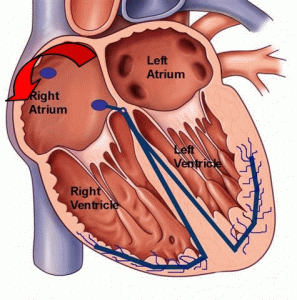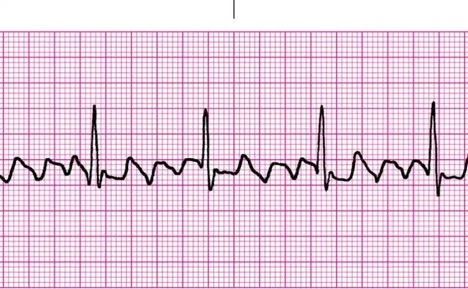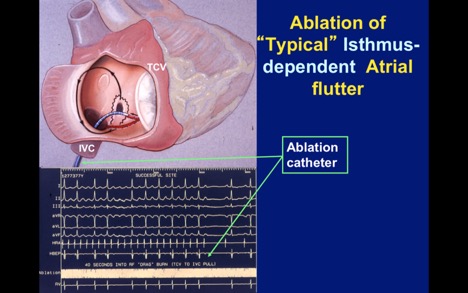Atrial Flutter
Atrial flutter is a heart rhythm disturbance that occurs in patients with similar risk factors to atrial fibrillation (advanced age, high blood pressure, sleep apnea, etc) and, therefore can coexist with atrial fibrillation. It is a rapidly organized rhythm of the top heart chambers (atrium), where the electrical impulse travels in a circular way around an obstacle (scar or a heart valve), causing the heart rate to be elevated.
What Causes Atrial Flutter?
 In patients with atrial flutter, the electrical activation of the heart starts rotating around the tricuspid valve – a valve that separates the right upper and lower chamber. This starts what we call reentry, where the electrical activity spins around the valve in a never-ending fashion.
In patients with atrial flutter, the electrical activation of the heart starts rotating around the tricuspid valve – a valve that separates the right upper and lower chamber. This starts what we call reentry, where the electrical activity spins around the valve in a never-ending fashion.
The AV node will regulate how many impulses will go down into the ventricles, and hence, how fast your heart will be. While most patients with atrial flutter have a fast heartbeat, it is not unusual for some patients to develop very slow heart rates.
Other risk factors associated the the presence of this heart rhythm problem are previous heart procedures, such as catheter ablation for atrial fibrillation, coronary bypass surgery, heart valve surgery, and surgery to correct congenital heart problems.
Problems Caused by Atrial Flutter
Much like atrial fibrillation, atrial flutter can cause strokes, symptoms, and congestive heart failure. Not uncommonly, patients with atrial flutter present with very fast heart rates, and prompt treatment to slow down the heart or to restore normal sinus rhythm is very important in order to prevent other problems.
Common Symptoms of Atrial Flutter
Patients with atrial flutter can present with symptoms of feeling rapid heartbeat, “flip-flopping” in the chest, intolerance to exercise due to difficulty breathing, fluid retention manifested by ankle swelling, and difficulty laying flat in bed. Other symptoms include:
- Palpitations
- Irregular heartbeat
- Fatigue
- Shortness of breath
- Chest pain
- Dizziness
- Heart racing
- Heart fluttering
The diagnosis is made with an electrocardiogram or heart monitor showing an organized (saw tooth-like) electrical activity of the top heart chambers.

As with atrial fibrillation, patients with atrial flutter require treatment to:
- Slow their heart rate and avoid excessively fast heartbeat;
- Restore rhythm to normal by electrical shock to the chest (cardioversion), medicines to restore and maintain rhythm, and more effective catheter ablation;
- Prevent stroke with blood thinners.

Catheter Ablation of Atrial Flutter
Atrial flutter ablation is the only definitive treatment option for patients with flutter and it has very high cure rates (over 95%), with very low risks. The procedure is commonly done as an outpatient, same day procedure. It is performed under sedation or general anesthesia, with a set of catheters placed from the groin blood vessels.
3-D Mapping of Cardiac Arrhythmia
The electrical circuit responsible for the flutter is mapped with sophisticated, state of the art computers to determine the precise area to be cauterized (ablated) with Radiofrequency energy, to terminate the flutter and eliminate the circuit responsible for it, therefore preventing effective its re-occurrence.

In summary, atrial flutter is a condition that can cause some of the same problems seen with AFib, such as increased risk of stroke and symptoms. However, flutter is caused by abnormal electrical activity around the tricuspid valve. Although it can be treated with medications, it frequently recurs. Catheter ablation is considered the best option for patients with atrial flutter.
Final 3-D Mapping of Atrial Flutter
Dr Jose Osorio
Miami, FL
Read More About AFib:
